Entries tagged with “Piemonte”.
Did you find what you wanted?
Thu 6 Jan 2011
Dolcetto is a black wine grape variety widely grown in the Piedmont region of northwest Italy. The Italian word dolcetto means “little sweet one”, but it is not certain that the name originally carried any reference to the grape’s sugar levels: it is possible that it derives from the name of the hills where the vine is cultivated. In any case the wines produced are nearly always dry. They can be tannic and fruity with moderate, or decidedly low, levels of acidity and are typically meant to be consumed one to two years after release.
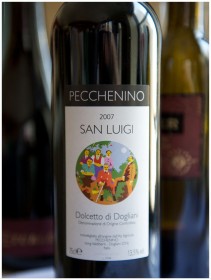 Dolcetto wines are known for black cherry and licorice flavours with some prunes and a characteristically bitter finish reminiscent of almonds. While the name implies sweetness, the wines are normally dry. The tannic nature of the grape contributes to a characteristic bitter finish.
Dolcetto wines are known for black cherry and licorice flavours with some prunes and a characteristically bitter finish reminiscent of almonds. While the name implies sweetness, the wines are normally dry. The tannic nature of the grape contributes to a characteristic bitter finish.
Recently our friend Diana, who runs the great B&B Baur in Aqui Terme, about an hour away from TorreBarolo, visited the town of Dogliani and these are her thoughts:
“A few weeks before Christmas my husband had the idea to take a ride over to the Langhe to taste some wines. He had a specific goal: he wanted to go to the Bottega del Dolcetto di Dogliani, the regional enoteca that is snuggled below the Municipio, right next to the splendid Chiesa dei Santi Quirico e Paolo in the heart of the city.
We had been to the enoteca before; it was from there that we visited the wonderful Chionetti winery for the first time in 2005. Dogliani was actually the center of our property search in 2001 and 2002 before we discovered our hill in the Monferrato. Contructed in the 12th century, Dogliani lies at the basin of the Barolo Valley. The nutrients and minerals that help the Nebbiolo grapes to flourish wash down to provide the perfect conditions for growing the Dolcetto grape. Of the eight zones officially designated to produce Dolcetto DOC, Dogliani is one of the top two. In 2005, Dolcetto Superiore di Dogliani received its DOCG status. With a minimum of 12.5% alcohol content and a hint of oak (the level depending on the winery) aging, Docetto has moved from a sharp, high tannin, low acid, quick-to-table wine with a slightly bitter residual flavor to a more rounded, softer wine that can sit in the bottle a few more years before being enjoyed with a variety of dishes typical to the region.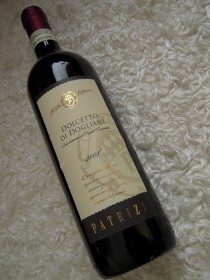
Enzo Romano, who runs the bottega, greeted us and helped Micha find the selection of wines he had been searching for. The Enoteca Regionale in Dogliani is one of the most organized and best run enoteche in the system. It has a current selection of all the producers in the appellation and a good breath of different vintages as well. Enzo helped Micha put together a healthy selection of twelve bottles of Dolcetto, both regular and superiore (wooded), for us to try. After trying, we notate the bottles we like the best and make appointments to visit those wineries.
An ideal combination of classic Piemontese food and wine might be. brodo broth made from winter capon served with boiled vegetables and agnolotti Piemontesi, alongside a 2008 Dogliani Bricco DOCG from the Cascina Minella, a vineyard brought to new life in 2002 by Livia and Gianluca Marchisio. I love this wine. It’s everything a good Dolcetto should be. It has character and bite without being agressive. Its 14% alcohol content and fullness of flavor speak of the patience and timing that the Marchisios exercised in picking the correct moment to harvest.
Dolcetto is not an easy wine to get right. We’ve been experimenting with the wine (from the tasting perspective) for years. To find dolcetto that truly maximizes the grape’s potential requires a producer with excellent soil conditions, the willingness to dedicate precious, southern exposure territory to a relatively humble wine, a sixth sense of timing regarding the harvest, the ability to stave off the many diseases this grape can contract and strong cellar knowlege. In our opinion, the two regions that have a concentration of these types of Dolcetto wineries are most likely to be found in Dogliani and Diano d’Alba.
Of course, there is tremendous enjoyment attached to searching out really spectacular wines from the bunch. Especially when that search takes you through some of the most bucolic and historic growing regions in Italy. We look forward to sharing our thoughts on the wines we’ve bought as we try them.”
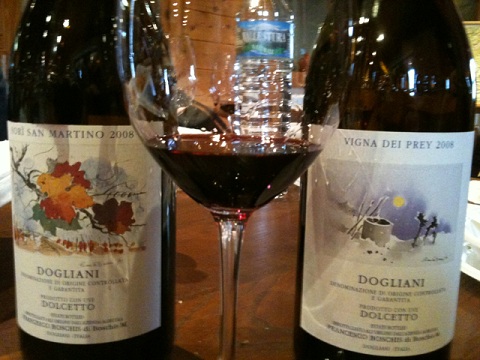
Tue 16 Nov 2010
As it was only 15:00 by the time I had completed both my lunch and giro of Asti, it was too early to head back to TorreBarolo, so I figured I may as well check out Alessandria as it was only 35km away. Alessandria is much bigger than both Alba and Asti, as evident by the fact that it has multiple exits on the Autostrada. So again, using my tried and tested method of heading towards “centro” and Piazza Liberta, I found myself in the center of the historic section of Alessandria. Again, I was surprised by the ample outside parking lots in the city center.
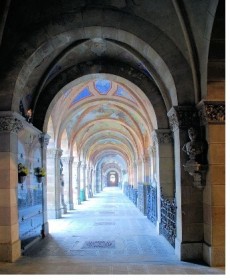 After referring to the little map of Alessandria in my Italy road atlas, I headed off towards Corso Roma, as anything with a “Roma” tends to be the city’s shopping street. At first I wasn’t too impressed but as I kept walking down this very long pedestrian street lined with various clothes and jewellery shops, I began to enjoy my stroll more and more as the well restored historic buildings lining the street really gave it a nice charm. My stroll brought me to very impressive Piazza Garibaldi. The porticos were especially impressive and added elegance to this square.
After referring to the little map of Alessandria in my Italy road atlas, I headed off towards Corso Roma, as anything with a “Roma” tends to be the city’s shopping street. At first I wasn’t too impressed but as I kept walking down this very long pedestrian street lined with various clothes and jewellery shops, I began to enjoy my stroll more and more as the well restored historic buildings lining the street really gave it a nice charm. My stroll brought me to very impressive Piazza Garibaldi. The porticos were especially impressive and added elegance to this square.
Another thing I have learned over the year is that a very nice bar (i.e., with table cloths and waiters) tends to be located on these beautiful historic piazzas. I spotted one but kept on walking as I wasn’t in need of a rest just yet. Heading away from Pizza Garibaldi up Via Maestra is when I really started enjoying my mini-adventure to this new city. Again, the street was lined with historic, well restored building though instead of clothing stores, store after store was a bakery, a pastry shop, a butcher, a fishmonger or a fruit and vegetable vendor.
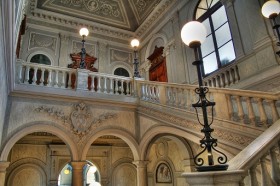 My favourite was checking out the “delis” with the cured ham hanging above the counter and the massive stacks of DOP parmigiano cheese. There was also an ample section of fresh pasta stores and one had some yummy looking take-away lasagna that I considered as an easy dinner option. The street was lively as it was now past 5pm and it was fun to watch all the ladies in their fur coats do their evening shop.
My favourite was checking out the “delis” with the cured ham hanging above the counter and the massive stacks of DOP parmigiano cheese. There was also an ample section of fresh pasta stores and one had some yummy looking take-away lasagna that I considered as an easy dinner option. The street was lively as it was now past 5pm and it was fun to watch all the ladies in their fur coats do their evening shop.
I stumbled upon a lovely arcade and tucked inside was a quaint café/patisserie. With the table cloths, wooden chairs and ladies having tea, I knew this was the perfect place to settle down for some refreshment and a read of the Herald Tribune I bought back in Asti. What a pleasure it was to find they served bicerin, which is the sumptuous hot drink that consists of layers of thick rich hot chocolate, espresso and fresh cream that originated in Turin.
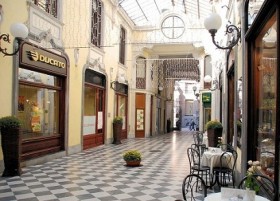 A glass of this is a meal almost, but I couldn’t resist sampling some of the yummy biscuits they had in their cases. By the time I left 40 minutes later, the tables were all filled by parents treating their kids or elderly couples having a little treat.
A glass of this is a meal almost, but I couldn’t resist sampling some of the yummy biscuits they had in their cases. By the time I left 40 minutes later, the tables were all filled by parents treating their kids or elderly couples having a little treat.
By this time it was getting colder and darker, so I thought time to head back to TorreBarolo.
So, would I recommend you have Alessandria as a day trip destination? That is tough call. It takes a bit of effort to find the old town center and doesn’t offer anything like the regal pizzas in Turin with the gorgeous turn of the century cafes. Instead, it offers no tourists, some pretty piazzas and a nice stroll down streets that you wish you had in your own neighbourhood. No question, Alessandria was a pleasant surprise but if I had limited time in the area I don’t think it offers enough to make it a day trip destination…….but I am glad I made the effort.
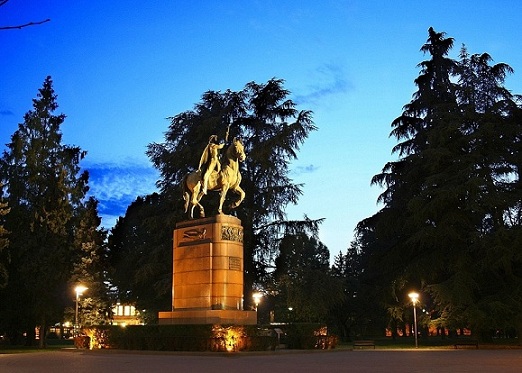
Thu 1 Jul 2010
 Our wine guru Gary Chevsky, back in November 2009, experimented with some Barbera wines from Piemonte:
Our wine guru Gary Chevsky, back in November 2009, experimented with some Barbera wines from Piemonte:
“Unclear why anyone would want to drink aged Barbera, a wine grape that is associated with easy quaffing and everyday meals. In the land where Nebbiolo is firmly the king, why mess with that? Let Barbera and Dolcetto play their lowly part in the food chain. Affordable, refreshing, satisfyingly easy drinking table wines. What would the world do without them, no?
But of course someone is always ready to challenge status quo, try to make an eagle out of a sparrow, a Boeing out of a paper plane. Treat Dolcetto like a more serious grape, and you get Dolcetto di Dogliani, deeper, richer, more ageable. Treat Barbera like that, and what do you get?
On Monday, a small group of enthusiasts got together at a Ross Bott tasting in Los Altos to assess 1999-2001 Barberas by La Spinetta. La Spinetta has a “standard” or lower-end Ca’ Di Pian wine that costs in the teens, and a higher-end wine that costs $40-50. Having tasted Gaja’s 1995 Barbera “Sitorey” earlier this year and having found it a powerful, fresh, and nuanced wine, my expectations were mixed. After all, that was Gaja! Could anyone else approach that effort?
From the mailer by Ross Bott, the organizer:
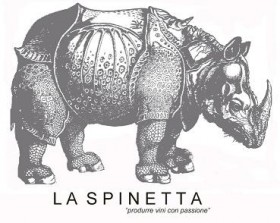
“Barbera is the third most planted red grape varietal planted in Italy, after Sangiovese and Montepulciano. Although planted in many of the northern Italian provinces, it is at its best in the Piedmonte region area around Asti, where it has DOCG status, Italy’s highest classification.
The varietal is naturally high in acid and low in tannins, and, when vinified in a lighter style to be drunk young, is a fine everyday wine to complement pastas and other northern Italian dishes. However, when yields are kept low and the grapes are harvested at riper levels, the resultant wines can be deep, complex and long aging, and marry particularly well with new medium toasted (or charred) oak barrels. Ironically, this approach is a relatively recent phenomenon in Piedmonte. In fact, some of the earliest examples of this approach were in the Shennandoah Valley in California, where Montevina made some great old Special Selection Barberas in the late 1970s — to my view the most exciting wines ever to come out of the Sierra Foothills.
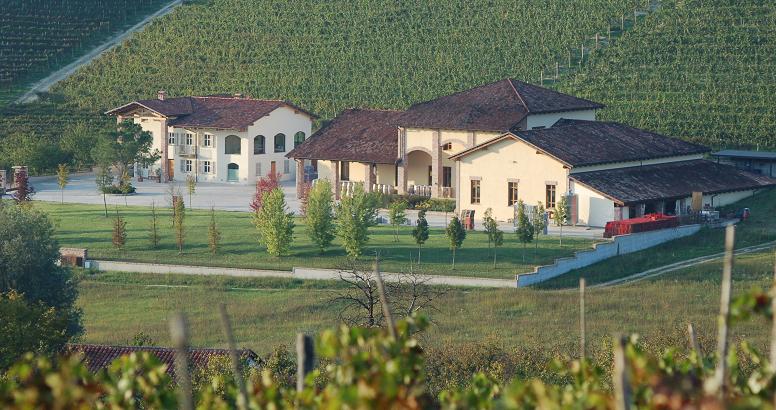
In 1998, Giuseppe Rivetti began to make a Barbera Superiore under his La Spinetta label, a serious, high-end approach involving old vines, low yields, and aging for 12-18 months in new French oak. Rivetti was born in Argentina, but his family was Piedmontese, and he returned in 1977 to the Asti region, in an area then known for Moscato d’Asti, a fragrant, low alcohol wine made from a varietal in the Muscat family. After producing some landmark examples of this white wine, he ventured into reds in 1985, first with Barbera and later adding Barbarescos and Barolos. He produces three Barberas a year, a Ca’ Di Pian which is richer and riper than most Barberas, but sees less oak, a Gallina from a single vineyard which also provides the grapes for his Barbaresco, and a Superiore, which is a reserve bottling from a selection of his best barrels. Both of the latter get extended barrel treatment and are among the three or four best Barberas produced anywhere.
Tonight, we’ll try six La Spinetta Barberas, a pair from each of 1999, 2000 and 2001. One member of each pair will be the lightly oaked Ca’ Di Pian and the other an example of his highest end Barberas which get extended treatment in new oak.”

From what La Spinetta I have tasted, it seems to have a ripe fruity style, perhaps closer to new world than old. On the photos below, the wines are ranked right to left in the order of scores. Easily in our blind tasting, the group ruled that more expensive wines beat out the cheaper ones. Though drinkable, the lower-end ones obviously not built for aging were slightly pickled, dusty, and funky. The higher-end “Superiore” and “Gallina” were in perfectly good shape, maintaining fresh fruit.
While the top 3 wines still “showed” young, it is as if they had artificially been beefed up to last longer, and the age did not give them subtlety, complexity, and secondary flavors that I’ve seen develop in properly aged ageworthy wines. It seemed rather pointless to me to spend $45 a bottle, then cellar it for 10 years, when in that range one finds some wonderful Nebbiolo and Sangiovese options. While obviously we confirmed Barbera’s ageability, I would not call that ageworthiness. It bothered me that the wines lacked finesse and complexity, and the question that firmly stuck in my mind was – “What’s the point!???”
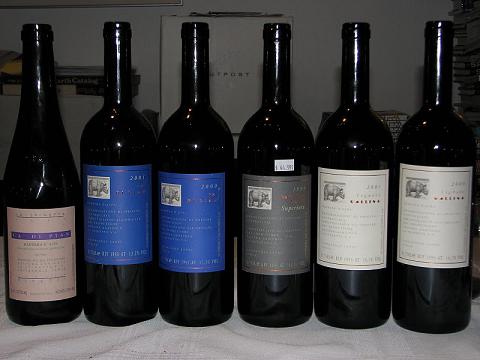
Thu 3 Jun 2010
Our friend Nancy Yos, of blog At First Glass, kindly shared with us her thoughts on a 2006 Vobis Tua Barbera d’Asti from Cantine Volpi. Nancy has been blogging for three years and her posts cover a wide range of wines and regions.
2006 Vobis Tua Barbera d’Asti
Producer: Cantine Volpi s.r.l., Tortona, Italy.
Light bodied, briny piquancy — tart, underripe raspberries – a little tarry or smoky — needs food
2nd day: mellowed and silkier 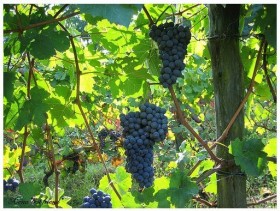
Barbera d’Asti is both a grape and a DOC (Denominazione di Origine Controllata) but note that smaller case b-barbera is the grape, while capital B-Barbera d’Asti refers to the DOC, in the lovely Piedmont region of northwest Italy, spelled in Italian Piemonte. If Italy generally conjures up images of sunshine, rolling hills, Rome, Renaissance art, and pasta, for Piedmont in particular we ought to think instead of mountains (the Alps), rushing rivers (the Po), drifting fogs, of industrial Turin, and oddly enough of rice and corn cultivation. Both are major crops here (think risotto and polenta).
For its part, our glass of Barbera d’Asti represents a sort of little brother in a hierarchy of Piedmont’s red wines, ranking below the great Barbaresco and the still greater Barolo, both named for their places of origin within Piedmont but vinified from the nebbiolo grape — which in turn is named, it seems, for the drifting fogs (nebbia). Barbera can be either Barbera d’Asti, as we have here, or Barbera d’Alba; the latter is considered just slightly more of a heavyweight than the former, which seems to be why Barbera d’Asti is an everyday what’s-for-dinner wine in this part of Italy. Barbera d’Alba is also another DOC.
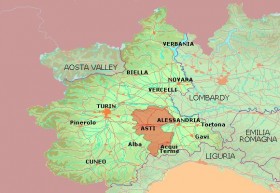 Like so many Italian red wines, except its powerhouse big brothers Barbaresco and Barolo, a Barbera has that tart, light, berry-like flavor and a texture that seems a little grainy and rough, as if a few seeds of a fresh raspberry had found their way into the bottle and added their own little interesting zip there.
Like so many Italian red wines, except its powerhouse big brothers Barbaresco and Barolo, a Barbera has that tart, light, berry-like flavor and a texture that seems a little grainy and rough, as if a few seeds of a fresh raspberry had found their way into the bottle and added their own little interesting zip there.
Wine books always emphasize that Italian wines like this, tending to be thin, fresh, and acidic, are meant to be drunk with a meal and not treated as a free-standing cocktail, which is often how we drink syrupy, barbecued-fruit California cabernets or merlots. Karen MacNeil in The Wine Bible writes rapturously of the Piedmontese food that would go with a Barbera, or even better, with its muscular big brothers, Barbaresco and Barolo: heavy meat dishes, thick risottos, eggy fresh-made pastas dressed only with butter and sage leaves or, if you are lucky and are visiting in the fall, with shavings of white truffle from Alba. The truffle’s spectacular taste, MacNeil explains in a sidebar, has been studied in science labs, and has been found to derive from some sort of chemical that is also present in the testes of men and bulls. Experienced people hunt for them at night in secret, with specially trained white dogs. Wasn’t there a commercial jingle that used to assure us Italians have more fun?
Indeed they seem to, and another of Italy’s most fun wines, Moscato d’Asti, is also a product of this same Piedmont that gives us our very serious Barolos and our zippy Barberas. Of this, I can provide just one quick tasting note: it’s flying off the shelves in grocery stores now, outperforming even queen Chardonnay and princess Pinot Grigio.
Vobis Tua, we are told, is Latin for “as you like it.” We like it. Retail: about $10-$12.
Mon 17 May 2010
A couple of weeks ago, I talked about Alba as a classic regional Piemonte town. One reason I am a big Alba fan is due to the numerous foodie and wine events the city host throughout the year. Given TorreBarolo is just a 15mins car ride to Alba, it is easy to get there and enjoy these events for a few hours. Moreover, given the size of Alba, these events are low-key affairs where you don’t have to worry about queuing to sample a selection of wines or walking endlessly around a huge convention center.
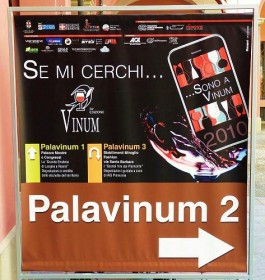 The International White Truffle Fair that commences in October for 2 months is well known and attracts serious foodies given the passion that exists for this mysterious musty smelling fungus. One event that is less well known is Vinum, Langhe and Roreo’s annual wine festival. Vinum’s function is to showcase the mom and pop wineries as well as the regional stars. As many of the smaller wineries don’t export outside the region, I see Vinum as an excellent opportunity to familiarize myself with the vast offerings from the local producers. Also exciting is that the producers use Vinum as the event to release new vintages of Barolo and Barbaresco.
The International White Truffle Fair that commences in October for 2 months is well known and attracts serious foodies given the passion that exists for this mysterious musty smelling fungus. One event that is less well known is Vinum, Langhe and Roreo’s annual wine festival. Vinum’s function is to showcase the mom and pop wineries as well as the regional stars. As many of the smaller wineries don’t export outside the region, I see Vinum as an excellent opportunity to familiarize myself with the vast offerings from the local producers. Also exciting is that the producers use Vinum as the event to release new vintages of Barolo and Barbaresco.
Recently Alba hosted the 34th edition of Vinum and although I was able to attend, being 7 months pregnant did put a damper on being able to enjoy any of the tastings. The set up this year was different than other years I have attended as this year the organizers decided to contain all the events within three separate marquees/exhibition centers. (I must say I preferred this to walking through the streets of Alba looking for the various kiosks).
This year’s three areas were divided into the following: 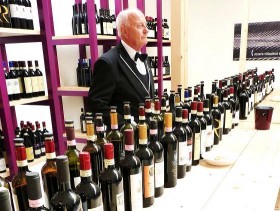
Palavinum 1: hosted the “Grand Langhe and Roero wines”. For €12 you would get a ticket book to taste 10 wines, a wine glass, a pouch to carry your wine glass in, a bottle of water and discount vouchers. For an incremental €4, a 2nd person could join you. Given the quality of wines in this exhibition hall, it looked like a deal to me, especially since I never saw many tickets exchanged and think that as long as you had a pouch and a glass you could go on tasting.
Palavinum 2: hosted both wine and food and was titled “Appetizing Encounters”. The price for this event was the same as Palavinum 1. The difference with this marquee was that the wines weren’t exclusively from the Langhe/Roero region and were from Piemonte in general, however, most of the placards I saw were of local vintners. Given I didn’t recognize many of the wineries in this marquee I am going to make the broad statement that this is where the smaller mom and pop wineries exhibit. Also in this marquee there were numerous food producers offering samples of everything from my favourite Castelmagno cheese, to the special Bra salsicca to the delicious local “Torte alla Nocciola” (hazelnut cakes). 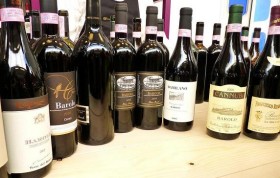
Palavinum 3: hosted the big dogs and instead of kiosks to walk around and sample various wines, there were set times for events and the prices reflected the prestigious wines on offer. For example, there was a retrospective of great Barolo vintages where participates sampled 16 wines for €40. Palavinum 3 events were spread over two days and there were many special events during these days to enhance your knowledge and appreciation of the region’s world famous wines.
Vinum extends over the last weekend in April and first two weekend of May. Mark your calendar for 2011 so you don’t miss out on this excellent wine lover event!
Wed 5 May 2010
I have written numerous posts in the last year, however, I have failed to write about the one little city (population: 30,000) that I have continuously enjoyed since I discovered the Langhe – Alba, the classic regional Piemonte town … and only a 15min car drive from TorreBarolo.
Often Asti, the main town of the Monferrato, has the pretentions of a provincial capital, however, I agree with those writers that cite Alba as a smaller community that happily conserves much of the best of Piemonte. 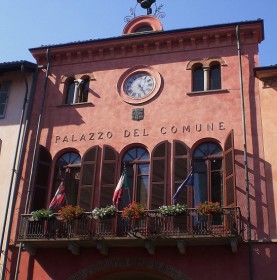
Between the end of the 12th and first half of the 13th century Alba enjoyed a period of prosperity, which expressed itself in the constructions of fortified buildings (towers) within the town. These towers were a mark of prestige as the higher the tower, the richer and more powerful the family that owned it. There are only four towers in Alba today that retain their original height and are concentrated around the Piazza del Duomo. There used to be so many towers that Alba came to be known as the town of a hundred towers. Although these towers characterize its medieval history, during the renovation of the medieval Palazzo Marro, Roman archaeological finds were uncovered showing traces of Roman Temple that existed during the 1st half of the 1st century AD.
Much of the essence of Alba can be experienced walking down Via Vittorio Emanuele and Via Cavour (both closed to cars) lined with a wonderful mixture of restaurants/cafes, enotecas, clothing stores and gourmet food stores (below I have listed a few). Being the main town in the Langhe, its no surprise that Alba hosts many wine and food related events showcasing the rich wine and truffle production (to be discussed in the second part of this post). However, there is more to Alba than just wine and white truffles as the city also sponsors numerous classical music/chamber music and film events throughout the year that continually refresh the city with new residents/visitors. 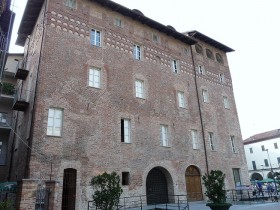
On a first visit to Alba I would recommend heading to the ample parking at Piazza San Paolo and then walking the few minutes to Piazza Savona, which is at the top of Via Vittorio Emanuele II, to begin your stroll. Before you turn left to walk under the short expanse of porticoes on Via Cavour you will enter Piazza Risorgimento (aka Piazza Duomo) with the medieval town hall straight ahead and Cathedral San Lorenzo to your right. Very little remains of the principal cathedral that was built between 1486-1517 and in its place is a neo-gothic cathedral built in the 19th century. Also in this piazza you will find the Alba tourist office that has an extensive selection of free information on local events/tastings/activities in English and German (the tourist office is open all day). Via Cavour is not a very long street so I suggest a little side diversion to Piazza E. Pertinace which is a nice little piazza that host a small organic food market on Saturday.
Most of the Albese stores shut for siesta so be sure to plan your stroll when the stores are open which is until 12:30/1pm and then between 4pm and 7pm. I suggest select a table at one of the numerous outdoor cafes – my favourite is Vincafé on Via Vittorio Emanuele 12 – and enjoy an aperitif during the evening “passeggiata”, when the locals come out to view and be viewed. Cin cin. 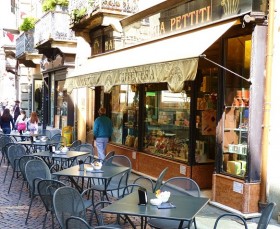
Bakeries and sweetshops
“Pasticceria Cheinasso”, Corso Langhe 88, famous for its torta di nocciole
“Io, Tu e I dolci”, Piazza Savona 12
“Sacco”, Via Cavour 9, for hazelnut cakes and rum macaroons
“Pasticceria Cignetti”, Via Vittorio Emanuele 5, a wonderful old bar/pasticceria since 1878, famous for its torrone. Also try the albesi al barolo (wine flavoured macaroons)
Bars and Cafes
Vincafé, Via Vittorio Emanuele 12, my long standing favourite cafè in Alba. They serve great food all day long and generally always have outdoor seating that offers a great spot for people watching.
“Casa del Caffè”, Via Macrino 1, a large roasting machine is in front as are sacks of beans for show. But you purchase from plastic containers that preserve the aroma of the beans. 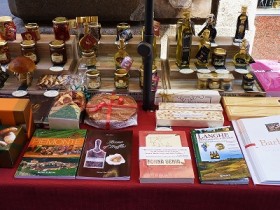
Dining
“Enoclub”, Piazza Savona 4, contact: 0173 220 629. Closed Monday and Sunday evening. Very good food. Restaurant located in the lower ground floor of a but the room is nice/charming (but no windows). Good service and wine list.
La Libera, Via E. Pertinance 24, contact 0173293 155. Closed Monday and Sunday. A more contemporary setting with glass and chrome tables that serves classic Langhe cuisine.
Osteria Dell’Arco, Piazza Savona 5, contact 0173 228 028. Closed Monday and Sunday. Tradtional setting with good traditional good. The rabbit cooked in Arneis is always very good.
La Piola, Piazza Risorgimento 4, contact 0173 442 800. This restaurant is unique in that it has only a choice of one “primo” and “second” each day but also always serves a choice of pasta and a choice of antipasti. It also shares a kitchen with the Ceretto family’s 1 star restaurant, Piazza Duomo, and so it has been my experience that the secondo is of a higher quality than one might expect for this level of dining. Both are owned by the Ceretto family, so all the wines are Ceretto (the white arneis Blangè being one of my favourite white wines). There is glass extension in front of the restaurant to eat at or else in the restaurant itself (which I always prefer for some reason).
“Ristorante La Capannina”, Borgo Moretta, Strada Profonda 21, this restaurant claims to have invented sliced carne cruda, the raw veal antipasto that is so popular in the Langhe.
“Vineria dell’Umberto”, Piazza Savona 4, closed Monday and August, this is a welcoming place for good food and excellent wine, the main reason to come here is to sample wines from a list that contains 200 selections.
A walk down Via Vittorio Emanuele, one of the main thoroughfares of Alba, contains many shops and stores that merit your attention:
- Cignetti, 5
- Pasta Fresca Corino, 9A
- Pasticceria Beretta, 16A
- Polleria Ratti, 18B
- Pasticceria Petitti, 25
- Ponzio Tartufi, 26
- Aldo Martino, 27

 Dolcetto wines are known for black cherry and licorice flavours with some prunes and a characteristically bitter finish reminiscent of almonds. While the name implies sweetness, the wines are normally dry. The tannic nature of the grape contributes to a characteristic bitter finish.
Dolcetto wines are known for black cherry and licorice flavours with some prunes and a characteristically bitter finish reminiscent of almonds. While the name implies sweetness, the wines are normally dry. The tannic nature of the grape contributes to a characteristic bitter finish.










 Like so many Italian red wines, except its powerhouse big brothers Barbaresco and Barolo, a Barbera has that tart, light, berry-like flavor and a texture that seems a little grainy and rough, as if a few seeds of a fresh raspberry had found their way into the bottle and added their own little interesting zip there.
Like so many Italian red wines, except its powerhouse big brothers Barbaresco and Barolo, a Barbera has that tart, light, berry-like flavor and a texture that seems a little grainy and rough, as if a few seeds of a fresh raspberry had found their way into the bottle and added their own little interesting zip there.  The
The 















